Patrick Huston completes his guide to choosing equipment with a look at a recurve archer’s stabilisation options
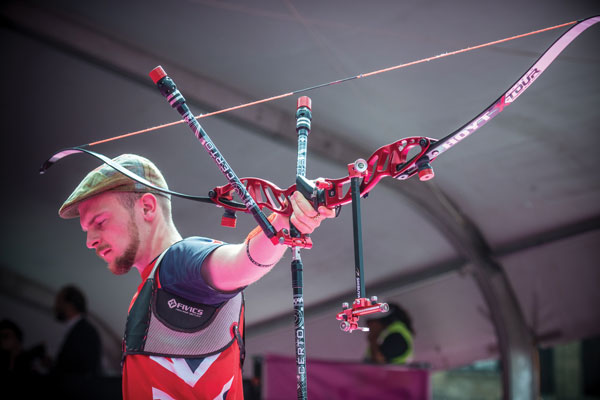
If you are wanting a softer feeling on the end of the shot then something with a little more flex is likely to give a nicer feel
Welcome to my third and final article on equipment in this series! I know it’s been a bit of a slog but as archers we have a lot of kit to play and experiment with. This article is going to discuss the rather large topic of stabilisers, and arrow bits like wraps and nocks, and then in the next issue – something else!
Rods
There’s really quite a lot to stick onto a bow. Shall we follow the path of the most obvious and talk about stabilisers next? My coach Richard Priestman would be awfully upset if I didn’t explain the logic behind his love affair with dampers!
I do have articles describing stabiliser set up, weight distribution, and so on, so I’m not going to go into that here. Essentially, stabilisers effectively have three jobs: they need to make the bow hold steadier at full draw (stiffness/weight); they need to keep the bow in that same position as the clicker drops and the arrow begins to move; and we would really like them to dampen the vibrations out of the bow and give us good feedback from the shot. As well as those considerations, there is also the effect of the diameter of the rod on wind drift to take into account.
Bearing in mind that stabilisers can have you spend from £50 to £1,500 if you really want, there’s a pretty wide range to choose from. For this section I’m going to group brands and ranges together and talk about the styles of shot or setup they suit, which will hopefully give you an idea of the kind of traits certain models have.
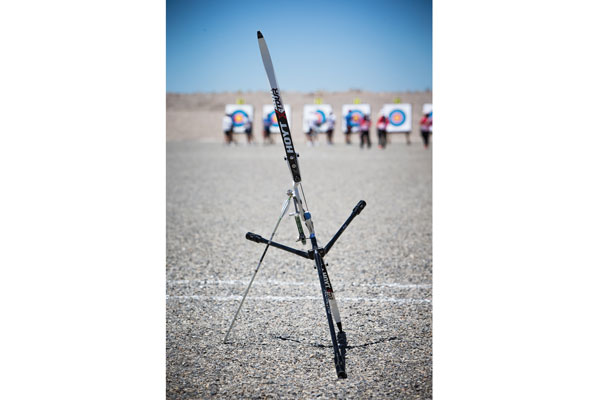
A heavy stabiliser setup will hold very steady at full draw but will require a lot of strength and practice to maintain form with
Some archers like big and heavy setups to hold really steady at full draw and have a neutral balance on follow through. The best rods for this are probably the Doinker Platinum series, Bee Stingers or Mybo Certos. These are heavy and chunky rods that will bear well to stacking up the weight and hold well with that load upon them.
Some recurve archers will want to shoot faster, with a fast-moving sight picture that involves more subconscious aiming and a gutsy follow through. First off you want to get an extender in there, and the biggest piece of advice is to go for a solid metal one! They have a habit of coming apart given the weight of a full V-bar, longrod and side rod setup. Mybo does a lovely one, as does Bee S tinger, but for a faster shot and follow-through you want to be going for something a bit lighter overall and put a bit less weight on. The HMC+ or WiaWis Rods from Win&Win will do this well. We’ve seen a lot of big scores shot with Fivics rods on the Korean bows, and also more recently the MK Korea rods. Shibuya does a nice and relatively low cost rod in the Ultima series which has worked well for some Japanese archers.
If you are looking for a really resilient feel that holds well in all conditions the new Gillo rods are hard to beat. They are well constructed with clever weight distribution that holds really nicely. Vittorio believes you should have a long extender and the side rods that finish about level with the grip, to give you an idea what they have been designed for.
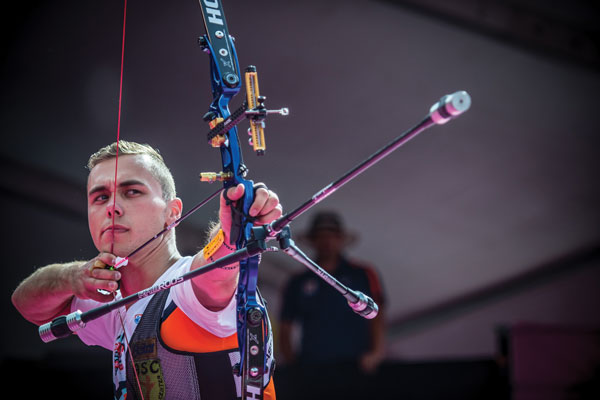
Narrow rods can be worth a try if you struggle to hold well in the wind
If you are wanting a softer feeling on the end of the shot then something with a little more flex is likely to give a nicer feel. Have a play with the Arc Systeme rods and a big floppy damper like JC Valldont uses, or perhaps the thin rods from Arctec. The Mybo Aeris line is gearerd more towards lower mass weight recurves and so gives a similar sensation.
Easton’s stabiliser range is currently quite extensive: the Z-Flex is a large diameter and stiff rod which will provide good stability and actually a respectable degree of dampening given the stiffness. The Contour rods favour a more front-heavy setup, but without dampers they can leave a lot of vibration in the bow. The Contour CS stabilisers have had some very favourable reviews from top archers about the feedback from the bow while reducing wind drift and holding well.
There’s also a trend these days for really thin rods. I think it’s a bit of a fad, though if you are weaker in the wind then you probably should avoid the fatter diameter stabilisers. Doinker made the Hero High Modulus at a ridiculous price point – but have been very impressed with sales. It is minute and very stiff. We’ve also got the new MK rods, which have been used to great effect by Kim Woojin et al, which I believe also provide nice damping and holding properties, and in this category of rods there’s also the Carbofast Slim Jim.
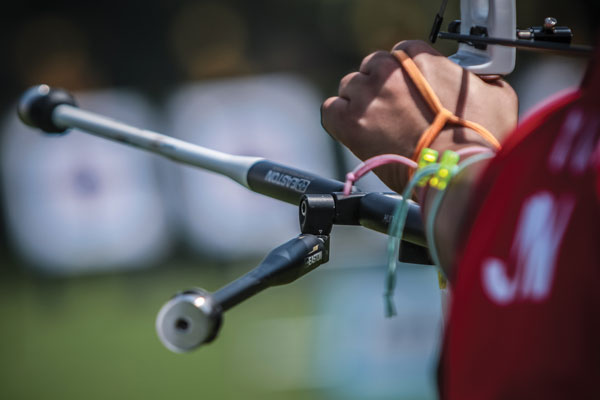
Easton’s Contour rods favour a front-heavy setup but have received good reviews
If you are looking for an all-round quality rod to experiment with, I’d say to take a look at the Mybo range (there’s going to be some new additions to it soon, too). The Certos are a really solid and reliable rod which can be loaded up with weight. They give a nice feel back up the arm and hold well. Their partner rods, the Aeris, are at a really affordable price range and give a lot of quality for the money, and the best thing is you can go to the Merlin shop in Loughborough or Durham and try them all out.
V-Bars and Dampers
Pretty much every recurve archer is going to have a V-bar set up on their bow. If weight is an issue and you want to make it really light then I recommend the Shibuya Caruno V-bar, it’s something like 28g! That’s pretty crazy, and yet solid as they come.
If that’s not the case then I would really recommend an adjustable V-bar. This just gives you far more options to play with to fine tune your stabiliser hold and set up. The Mybo adjustable V-bar is an absolute rock – once in place and locked down it just won’t move, and the new one has a nice feature in the in-built quick disconnects. The Gripper V-bar is a similar design, and the Doinker and Bee Stinger products are also very reliable. I’d avoid the AGF V-bar as the arms have a habit of shearing off if they have a lot of weight on or get banged – not really what you want! If you do get an adjustable V-bar, and once you’ve settled on a position (check out my other articles on how to best find that) make sure to mark on it with Tipex or similar, just in case it does move.
The last thing to discuss on the stabiliser front is dampers. My coach Richard Priestman (three-time Olympian and two-time bronze medallist) loves to have a well damped setup. He recommends a good floppy damper at the end of your rods to make the limbs close up well. His signature test for this is pulling the string in toward the limb tip and letting go, while holding the riser. The limbs should stop vibrating and wobbling very quickly if properly damped. He uses a piece of high-pressure hosepipe with a bushing within it.
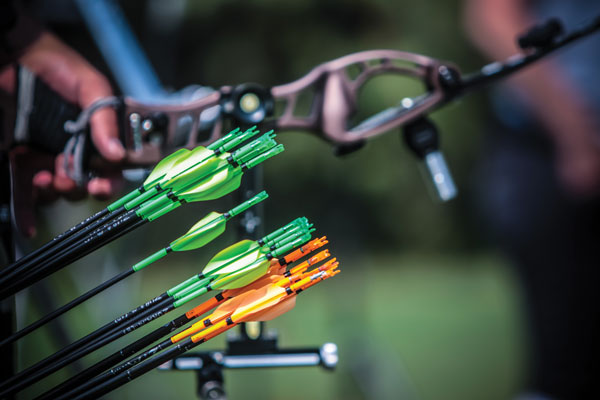
Wraps with vane markings on can make fletching easier
There are a lot of damper options out there at the moment. The Win&Win damper is pretty good quality, and Fivics have made a lot of good stuff over the years. Doinker have, of course, got their product name to be synonymous with the rubber damper as they have produced top quality Doinkers for years! I am currently running the new Doinker Exo which has two dampers held together with an exo-skeleton. They give two choices of the softness of rubber to put inside so there’s three choices to try; H/H, H/S, S/S – four if you try the hard/soft the other way round. You’ve probably seen the Doinker A-bomb about, both large and small are brilliant products and will serve you well whether on your rods or onto your bow. I am actually using the Mybo rod dampers with some converter threads in them on my riser, which work really nicely! The large surface area with a thinner flexing portion in-between reduces vibration from the limbs really well.
Wraps and Nocks
There are a lot of choices of what to stick on your arrows. Wraps or no? Personally I do use them as I think personalised colour schemes and funky designs look cool, and cool-looking stuff always shoots better. The incorporated fletching lines also make adding vanes really easy. There is an argument that they change spine of the arrow slightly, and some people think that after a manufacturer goes to a lot of effort to make an accurate arrow that you shouldn’t just stick a piece of vinyl on it, but plenty of people shoot them without a problem and it’s your arrows, your choice. When it comes to wraps, ArrowSocks provide and incredible service and can provide pretty much whatever you want – your challenge is to wind Adam Smith up with an awkward design more so than I do!
And finally, nocks. The main choices here are Easton nocks, Soma nocks or Beiter nocks. The Easton ones are cheap enough, and respectable quality given they have started doing single mould bags. Soma have been certified by Liam Grimwood in this very publication a while back as a very accurate nock, even over time. Beiter are probably the most popular, and their USP is that they are created by a medical supplies plastic manufacturer and all the nocks come from exactly the same mould, since they made each mould! They do, however, come with a bit of a price tag. I personally shoot Beiter Over nocks, meaning the plastic sits on the outside of the shaft. This reduces tolerance issues with multiple surfaces and should be more accurate, but some archers call them ‘suicide nocks’ given that they don’t provide the protection of the shaft that a pin and/or collar does in the event of a rear-end impact in the target.
Well there we have it… a three article ramble by Patrick Huston on most of the elements of equipment that a recurve archer will be using! I hope I’ve kept you interested and engaged, and hopefully even given you some new information.
This article originally appeared in the issue 121 of Bow International magazine. For more great content like this, subscribe today at our secure online store www.myfavouritemagazines.co.uk

